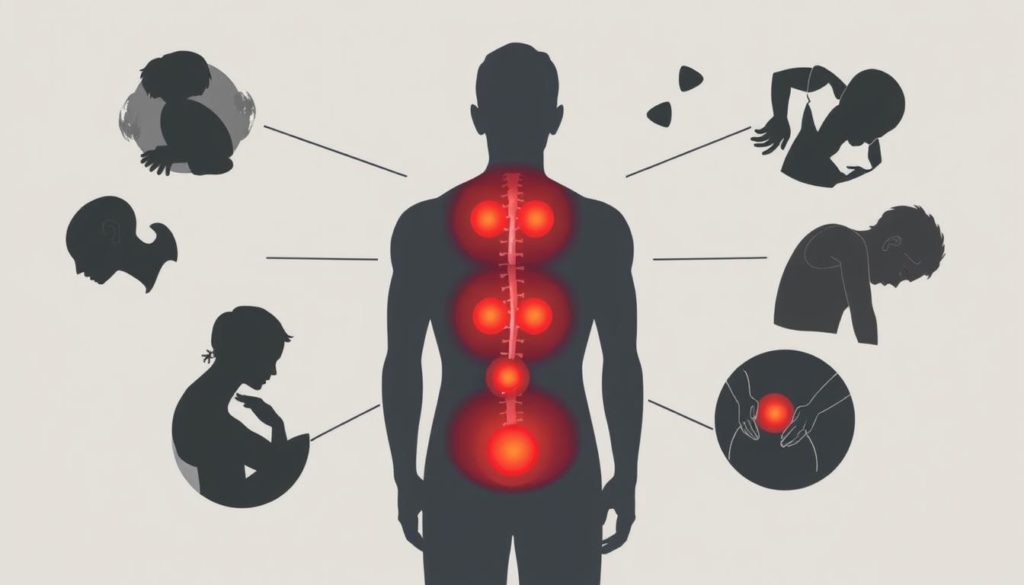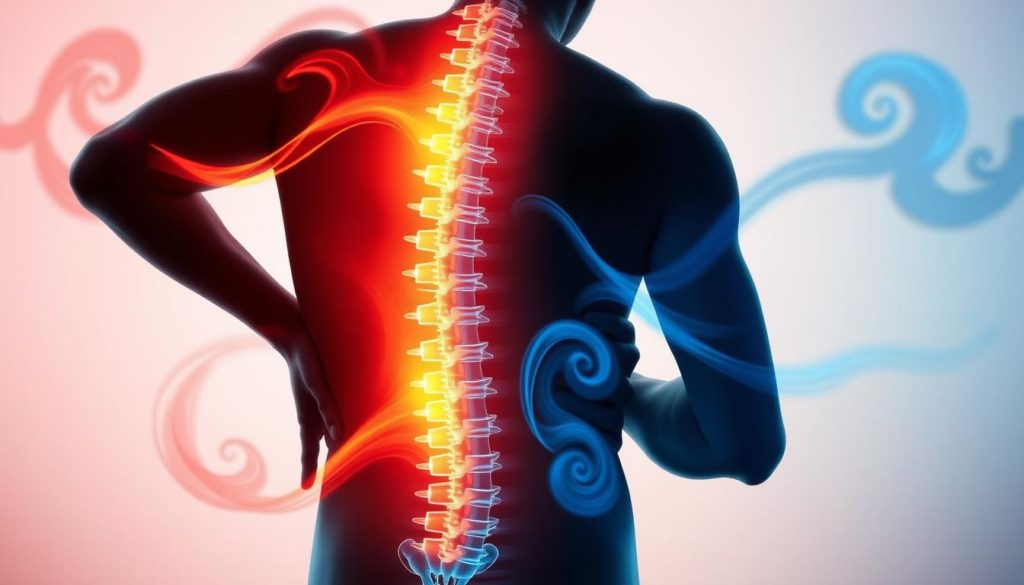Did you know back pain leads in causing disability around the globe? It affects over 540 million people at any time.
Back pain isn’t just a minor issue. Its common and lasting nature makes it a serious health problem. People of all ages can suffer from it. According to the National Library of Medicine and National Institutes of Health, the reasons for back pain vary with age. This requires accurate diagnosis and specific treatments to help patients and lower healthcare costs. This issue leads to around $200 billion in yearly costs from managing it. It also greatly impacts work time and productivity.
It’s vital to spot serious issues like tumors or cauda equina syndrome early. However, most people get better with proven, non-drug treatments that encourage staying active. This shows why knowing about back pain really matters for dealing with it well.
Dealing with back pain well means working together across different medical fields. This highlights the need to fully understand what back pain is and how it works.
We’ll explore the details of back pain further. We aim to share knowledge that helps in managing and easing this condition effectively.
What is Back Pain?
Back pain is a leading reason why people go to the doctor. It affects people of all ages. To grasp what is back pain, we look into its causes, symptoms, and how common it is.

Overview and Prevalence
Back pain is surprisingly common, affecting up to 23% of adults globally. It comes from different causes like mechanical issues. Knowing the cause through checks and exams helps in handling the pain.
Common Symptoms
There are many symptoms of back pain, such as sore spots that might mean cancer. Or ongoing pain, suggesting arthritis in the spine. Knowing these signs helps in treating back pain better.
Back Pain Definition
The term Back Pain Definition covers symptoms from different causes. These range from trauma to disease, and mental health issues. Knowing the difference between acute back pain and chronic back pain matters. It helps decide the right treatment.
Acute back pain starts suddenly and often gets better in six weeks. It’s usually due to injuries or muscle strains. Chronic back pain lasts over three months. It’s often caused by deeper health problems.

To find out what’s causing back pain, doctors do a full check-up and may use scans or X-rays. This helps them figure out the best way to treat it. Treatment can include medicine, physical therapy, or seeing a specialist. Getting the right diagnosis is key to treating back pain effectively.
| Type of Pain | Duration | Potential Causes | Treatment Approaches |
|---|---|---|---|
| Acute Back Pain | Less than 6 weeks | Injuries, Muscle Strain | Rest, Non-prescription Pain Relievers, Physical Therapy |
| Chronic Back Pain | More than 3 months | Degenerative Disorders, Inflammation | Prescription Medications, Specialist Care, Long-term Physical Therapy |
Causes of Back Pain
Understanding back pain causes is key to finding the right treatment. Back pain comes from mechanical, degenerative, and inflammatory reasons. These are the main types.
Mechanical Causes
Mechanical back pain is the most common, making up nearly 90% of all cases. It often comes from injuries, bad posture, or repetitive strain. These can compress the back.
Ignoring these issues can lead to big problems and pain. Heavy lifting, sudden moves, or sitting wrong for too long are typical causes.
Degenerative Causes
Degenerative back pain happens mostly because of aging or overuse. This weakens the bones and muscles. Things like disk problems are common here.
As we get older, our spines wear down. This can cause arthritis or spondylosis, leading to pain and making it hard to move.
Inflammatory Causes
Inflammatory back pain is about chronic inflammation. It’s not caused by infections or cancer. Illnesses like ankylosing spondylitis or arthritis are examples.
These diseases cause constant inflammation. This can hurt the spine over time if not treated.
To summarize the primary causes:
| Type of Back Pain | Cause |
|---|---|
| Mechanical Back Pain | Traumatic injuries, poor posture, repetitive strain |
| Degenerative Back Pain | Aging, intervertebral disk herniation, osteoarthritis |
| Inflammatory Back Pain | Ankylosing spondylitis, spinal arthritis, chronic inflammation |
Types of Back Pain: Lower vs. Upper
Understanding the types of back pain is vital for dealing with back discomfort. There are two main types: lower back pain and upper back pain. Each type has its own features and causes.
Lower Back Pain
Many people experience lower back pain. It affects the lumbar region and might spread across a wider area or down the legs. The causes vary from muscle strain to herniated discs.
It often arises from heavy lifting, poor posture, or sitting too long. These factors play a big role in lower back pain.
Upper Back Pain
Upper back pain is usually related to the cervical spine area. This kind of pain can spread to the neck and even the arms and hands. It’s often caused by poor posture, injuries, or conditions like arthritis.
Knowing about upper back pain is important for choosing the right treatments and prevention.
Problems with vertebrae, spinal joints, or muscles can lead to lower or upper back pain. It’s important to understand both types for proper treatment.
Chronic Back Pain: An Overview
Chronic back pain lasts for more than three months. It can be hard to figure out the cause, say Johns Hopkins Medicine experts. A variety of Back Pain Treatment Options are needed for this complex issue.
To ease back pain, you might need physical therapy, medicine, and lifestyle changes. These methods work together to tackle back pain from all sides. This complete approach can greatly help many people.
It’s important to understand chronic back pain well to treat it effectively. By using advice from top doctors and focusing on the patient, we can get better at managing back pain. This helps improve life quality.
Recognizing Back Pain Symptoms
Identifying back pain means knowing the signs and serious red flags. Let’s explore the important and usual symptoms:
Red Flags
Back pain varies in intensity, but certain symptoms mean you need immediate care. Knowing the signs of serious back issues is key. Look out for these critical pain indicators:
- Unexplained weight loss
- Focal tenderness
- Spinal procedures within the last 12 months
- Immunosuppression
- History of malignancy
Common Indicators
There are also common signs that come with back pain. These shouldn’t be ignored. These symptoms can tell you a lot about your back pain:
- Muscle spasms
- Local tenderness
- Stiffness
Knowing these common signs can help you spot back pain early. This makes diagnosing faster and can prevent long-term issues.
Effective Back Pain Relief Options
Finding the right Back Pain Relief method can be tricky. But there are many effective ways to tackle chronic back pain. Physical therapy, focusing on core strength and better posture, is one of the best non-surgical options.
It can greatly lessen discomfort and prevent more issues down the line. Mindfulness techniques, like meditation and controlled breathing, also play a key role. They address the mental side of dealing with pain.
Improving your diet can make a big difference too. Eating anti-inflammatory foods and keeping a healthy weight helps your back. Plus, changing small things in your day-to-day life is important. Taking breaks and knowing what worsens your pain are good steps toward management.
For severe pain, treatments like corticosteroids can offer quick relief. Acupuncture and massage are also effective for many people. Experts from Johns Hopkins Medicine and Dr. Stephanie Van suggest combining these methods. This integrative approach tackles the complex nature of chronic back pain.
Below are some nonsurgical treatment options for back pain:
- Physical therapy exercises
- Mindfulness techniques
- Diet improvements
- Lifestyle modifications
- Injection-based treatments
- Alternative therapies
Back Pain Treatment Options
Dealing with back pain means looking closely at different treatment methods. We will explore non-surgical and surgical ways to handle back pain. This gives you a full view of what you can do.
Non-Surgical Treatments
For non-surgical relief, lots of options exist. Physical therapy focuses on exercises to make muscles stronger and more flexible. Medicines like anti-inflammatories and muscle relaxants help ease pain and lower swelling. Making changes in your daily life, such as improving your workspace and staying active, is key for lasting relief. Check out this detailed guide for more info.
Surgical Treatments
Surgery is a step taken when other treatments don’t work. Options range from discectomies to spinal fusions, designed for specific spine problems seen in tests. But surgery doesn’t always fix the pain. Stephanie Van, M.D., from Johns Hopkins Medicine emphasizes trying conservative care first. This includes exercise, using mindfulness, and a strong plan for managing pain.
Talking to healthcare experts is vital to find the right back pain treatment options for you. By considering all paths, you can find the best way to feel better while keeping an active and healthy lifestyle.
FAQ
What is back pain?
Back pain is a common problem that affects people of all ages. It can show up as discomfort or pain in any part of the back. This can be due to various causes like injuries, aging, or inflammation.
What are the most common symptoms of back pain?
The main signs of back pain include discomfort, muscle spasms, and stiffness. In worse cases, people might lose weight unexpectedly, feel tenderness in one spot, or have pain that spreads to other areas.
What causes back pain?
Causes of back pain range from mechanical issues, like injuries, to degenerative problems due to aging. Sometimes, inflammatory diseases or serious conditions like infections or cancer could be the cause.
What is lower back pain?
Lower back pain affects the bottom part of the back and may extend to the legs. It’s usually caused by injuries, wear and tear, or habits like poor posture.
What is upper back pain?
Upper back pain impacts the neck, shoulders, and arms. It comes from the same issues as lower back pain, such as injuries or poor posture.
How is chronic back pain defined?
Chronic back pain lasts for more than three months. It can be unpredictable and hard to handle, needing a mix of treatments like therapy, medicine, and lifestyle changes for relief.
What are the red flags for serious back pain conditions?
Serious back pain signals include unexpected weight loss and tenderness. Other warnings are recent back operations, weakened immune systems, or cancer in the past. It’s important to seek help quickly if these signs appear.
What are the effective relief options for back pain?
Relief for back pain comes from exercises, staying mindful, and making lifestyle changes. Other methods include shots, acupuncture, and massage.
What are the non-surgical treatment options for back pain?
Treatments without surgery for back pain involve therapy, medication, and changing daily habits. The focus is on easing pain and getting better without needing surgery.
When is surgical treatment considered for back pain?
Surgery is usually the last option if other treatments don’t work. It’s for specific problems seen in medical images. However, surgery doesn’t always stop the pain and might not be the best choice. Doctors usually suggest trying other methods first.


